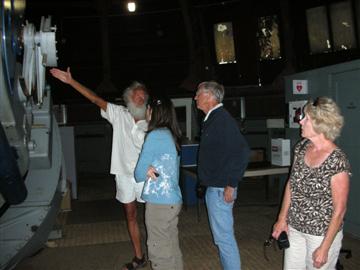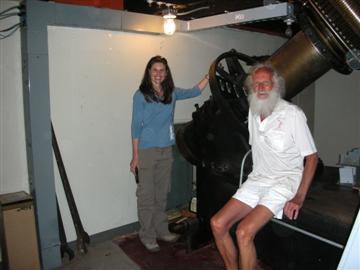|
Text and captions from Jack Eastman: What happened after this terrific All-Class reunion, was an all-day expedition to the historic Mt. Wilson Observatory.. Marilyn Hancock, one of my classmates from the class of 1957, had e-mailed me about the possibility of a trip up to Mt. Wilson sometime during the big reunion. I e-mailed Carla Johns, and we got everybody more or less connected. Carla was able to get the Monday after the reunion weekend off and agreed to host our bunch at Mt. Wilson. Marilyn agreed to pick me up at the hotel and pick up a couple others, Ernie Woods and Judy Cleland. We met up with Carla at the historic Bob's Big Boy hamburger joint in Burbank, had lunch and headed out. I didn't recognize much, but we were heading up from Burbank, not the route from Pasadena that I was used to. It still seemed like we were lost, we should have at least seen evidence of JPL, as the route, Highway 2, Angeles Crest, starts out only a mile or two from JPL. We turned down a tiny neighborhood street for several blocks which turned out to be Big Tujunga Canyon road. The short of it was from here the trip was probably three times as long as Angeles Crest. Angeles Crest was still closed all the way from La Canada to the turnoff to Mt. Wilson due to heavy damage from that huge fire last Fall. The countryside was truly devastated, looking like the surface of the moon. It reminded me of Mt. St. Helens several years after it blew it's top, nothing but bare ground. This was the scene most of the way to the observatory. We finally arrived at Mt. Wilson. Carla's plan was first, an in depth visit at the 60-inch reflector, then a walk around the grounds, and the grand finale, the 100-inch. |
||
|
View toward Mt. San Antonio, "Old Baldy" from where Michelson measured the speed of light in 1926 (Picture by Judy Cleland Bergen) |
Santa Anita race track and environs through the smog (Picture by Carla Johns) |
Ernie, Marilyn, and Jack, standing by the car (Picture by Judy Cleland Bergen) |
|
For an explanation of some of the
terms used below,
click HERE.
We went in the dome, and among other things, Carla and Todd dragged much food, munchies, and all to restock the pantry in the dome. We were able to look over the 60" in detail, go into the basement (Coude' Room, or maybe more properly the Clock Room) where the large gears are that move the telescope East and West (Hour Angle) could be seen. It sure seemed empty from my visits of a half century or so ago. The large weight-driven clock for tracking was gone, much of the mechanism for clamping and unclamping the drive gear was also gone, as was the "microscope" for reading the hour circle from the control desk upstairs. |
||
 Jack, Carla, Ernie, and Judy (Picture by Marilyn Lyon Hancock) |
 Carla and Jack in the Clock room, under the 60-inch telescope, showing gears and hour circle ( Picture by Marilyn Lyon Hancock) |
Looking at the mirror support mechanism, 60" (Picture by Judy Cleland Bergen) |
|
The telescope has been computerized and all
the motions, slewing, setting and tracking, are now done just with the
large worm gear that used to be only for tracking. Back upstairs, we saw
the extra "cages", upper sections to the telescope tube,
Newtonian focus, and the Coude' mirror. The Cassegrain mirror is the one
currently installed on the telescope. And there is an eyepiece! This
scope is no longer used all that much for research, but more for public
outreach, with viewing sessions for various groups including the Los
Angeles Astronomical Society. Carla moved the 'scope so we could try to
get a view of the mirror. We really didn't see it, but we did look at
the back of the glass through the mirror mount structure. St. Gobain
wine bottle glass - a beautiful emerald green. That glass is 60 inches
in diameter, 7.5 inches thick, and weighs about 1900 pounds. The
telescope floats on a large drum of mercury to relieve most of the
23-ton weight on the bearings so it can be moved with a minimum of
effort. The telescope was the world's largest active telescope when it
saw first light in1908 and the first truly research-grade reflector.
Remember, this instrument, all the heavy castings and the mirror, were
brought up a truly primitive trail largely by mule power!
After thoroughly going through the 60", we hiked down to the "monastery", the sleeping quarters for the visiting astronomers. This was a first for me, I'd never been past the shop/library/laboratory/pool hall building a bit further up the road. Carla didn't have the keys to that one; it would have been interesting to poke around in there and see if that really nice pool table was still there. I think every major observatory has a first class pool table! Lick and Palomar sure do. On the way, now to the dome of the 100", we stopped at the little "cook shack" at the end of the causeway to the 100". Carla explained that this little kitchen was placed out away from the telescopes because Hale, the first Director, was afraid of someone starting a fire in the dome if the kitchens were in the domes. |
||
|
Drive gears for the 60" showing the main gear motors and encoders (Picture by Judy Cleland Bergen) |
A picture of the original weight-powered driving clock of the 60" telescope. Click HERE for more info |
Jack showing Cassegrain eyepiece at the 60" (Picture by Judy Cleland Bergen)
|
|
View of the Monastery building (Picture by Judy Cleland Bergen) |
Million gallon cistern, water for fire fighting (Picture by Judy Cleland Bergen) |
Causeway to dome of the 100-inch telescope (Picture by Judy Cleland Bergen) |
|
Then it was on to the historic 100"
Hooker telescope. Up the three staircases, the first flight of 24 steps,
the number of hours in a day; the second, 15 steps, the number of
degrees in one hour (of right ascension or longitude) and the final one
of 13 steps, the (true) number of zodiacal constellations, adding up to 52, the number of weeks in
a year. These lead to
what is called the "bullring" immediately under this huge
87-ton piece of machinery.
Here, the mirror end of the telescope looks much like the nose of a large steam locomotive. Through a vent, one can look at the actual 9,000 pound piece of glass, emerald green with numerous bubbles, reminds me of St. Paddy's day - great quantity of green beer. The glass had to be cast in three melts which gave rise to all the bubbles. George W. Ritchey, the optician who was responsible for the grinding and polishing, and George Ellery Hale, the Director, rejected the first blank. St. Gobain tried again. http://www.mtwilson.edu/vir/100/mirror/ After more trepidation and deliberation it was finally decided to use the first piece of glass after all. Roughly 4½ tons of French wine bottle glass was ground and polished to a final accuracy of about a millionth of an inch to become the world's largest-ever telescope. Think of all those French wine bottles that gave their lives for the world's biggest telescope. The 100" saw first light in 1917.
The first view, Jupiter, was very disappointing, a really terrible
image. The telescope a failure? Hale and a couple of others returned in
the wee hours of the morning and tried again. Perfection! It seems the
dome had been open all day and the mirror was distorted by the warmth of
the day, but after settling most of the night, the distortions
disappeared, the telescope was a success. "Danger, Laser" signs are all over the place, part of the laser-induced artificial guide star for their advanced adaptive optics system, which measures the turbulence of the atmosphere and corrects for it, allowing a much sharper image than the telescope alone. Like the 60", the 100" is supported by mercury floats at both ends of the polar axis, allowing effortless moving of the 87-ton mass. The original driving clock was said to produce about 1/100th horsepower. Down in the bowels of the building we found the parking places for the upper cage sections of the telescope, the coude' mirror which sends the light to powerful spectrographs in the basement, the Cassegrain mirror, which is on the telescope and the empty place for the Newtonian focus. Empty, because this setup was given to the Smithsonian, no doubt with Edwin Hubble's favorite chair. It was a true piece of history to see the boxes, both here and at the 60" with names such as Baade, Zwicky, Humason, Adams, Pease, Babcock, Nicholson, and Hubble, the true pioneers of discovery that put Mt. Wilson forever on the map and made major advances in our knowledge of our universe. |
||
|
First (24 step) staircase to 100" observing floor (Picture by Judy Cleland Bergen)
|
Jack, Judy, Marilyn and Ernie standing on the mount of the 100-inch Hooker Telescope (Picture by Carla Johns) |
Jack in front of the 100" (Picture by Carla Johns) |
|
Control desk at the 100", Sidereal clock and eyepieces for reading the setting circles on the telescope (Position of the telescope) (Picture by Judy Cleland Bergen) |
Dome part of the shutter opening and closing mechanism (Picture by Judy Cleland Bergen) |
More of the dome shutter mechanism at the 100" (Picture by Judy Cleland Bergen) |
|
Jack, Ernie and Marilyn under the North mercury bearing of the 100" (Picture by Judy Cleland Bergen) |
Jack climbing onto the South mercury bearing of the 100" (Picture by Judy Cleland Bergen) |
Jack behind the control desk, standing on the 100" (Picture by Judy Cleland Bergen) |
|
Top of 100" looking out at the sky (Picture by Judy Cleland Bergen) |
Eye end of the 30-cm refractor of the Griffith Observatory (Tuesday's trip, 2 pictures by Carla Johns) |
Jack and Carla |
|
If you want to read more about these
discoveries over the 100 or so years, for which Mt. Wilson was a leading
player, there's a truly wonderful book, "The Day we Found the
Universe" by Marcia Bartusiak, ISBN 978-0-375-42429-8. One of the
best ever books I have ever read. Alas, all too soon we were heading out. We didn't get over to the Solar Telescopes, that'll have to wait for another trip. We headed down to Pasadena and had a wonderful Mexican feast at El Cholo, highly recommended by Carla, a fitting conclusion to a truly wonderful day. Many heartfelt thanks to our wonderful hosts, Carla and Todd Johns of the Mt. Wilson Observatory association |
||